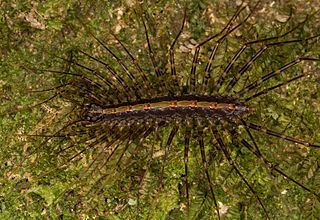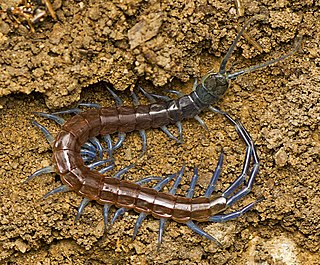
Ethmostigmus rubripes, commonly known as the giant centipede, is a species of centipede in the family Scolopendridae. It is a solitary nocturnal predator found across Asia and Oceania, with three subspecies currently described.

Cormocephalus rubriceps, also known as the Hura or giant centipede, is a large centipede of the family Scolopendridae. It is native to Australia and New Zealand, where it is found in the North Island and on islands off the North Island. At up to 25 cm in length, it is the largest centipede in New Zealand.

Scolopendra hardwickei, the Indian tiger centipede, is a species of centipede in the family Scolopendridae.
Orphnaeus brevilabiatus is a species of centipede in the family Oryidae.
Cormocephalus westwoodi is a species of centipedes in the family Scolopendridae. The species was previously considered by many names in many regions of the world, where some synonyms are still exists valid in certain countries. Five subspecies are currently recognized.

Pselliodidae is a family of small centipedes, identical and closely related to house centipedes.
Cryptops australis is a species of centipede in the Cryptopidae family. It was first described in 1845 by British entomologist George Newport. It occurs in Australia, New Zealand and Melanesia.

Rhysida nuda, also known as the blue-legged centipede, is a species of centipede in the Scolopendridae family. It is endemic to Australia, and was first described in 1887 by British entomologist George Newport.
Cormocephalus turneri is a species of centipede in the Scolopendridae family. It is endemic to Australia, and was first described in 1901 by British zoologist Reginald Innes Pocock.
Steneurytion morbosus is a species of centipede in the Geophilidae family. It was first described in 1877 by New Zealand naturalist Frederick Hutton.
Tasmanophilus is a genus of two species of centipedes, in the family Zelanophilidae. It was described by American biologist Ralph Vary Chamberlin in 1920. Centipedes in this genus are found in Australia and New Zealand.
Tuoba laticeps is a species of centipede in the Geophilidae family. It is endemic to Australia, and was first described in 1891 by British zoologist Reginald Innes Pocock.
Tuoba sydneyensis is a species of centipede in the Geophilidae family. It was first described in 1891 by British zoologist Reginald Innes Pocock.
Henicops dentatus is a species of centipede in the Henicopidae family. It is endemic to Australia. It was first described in 1901 by British zoologist Reginald Innes Pocock.
Henicops maculatus is a species of centipede in the Henicopidae family. It was first described in 1845 by British entomologist George Newport.

Lamyctes emarginatus is a species of centipede in the Henicopidae family. It was first described in 1844 by British entomologist George Newport.
Australiophilus ferrugineus is a species of centipede in the Zelanophilidae family. It is endemic to New Zealand. It was first described in 1877 by New Zealand biologist Frederick Hutton. Since then, authorities have recognized two junior synonyms, deeming Geophilus huttoni a synonym in 1936 and Geophilus polyporus a synonym in 2014.
Tasmanophilus spenceri is a species of centipede in the Zelanophilidae family. It is endemic to New Zealand. It was first described in 1901 by British zoologist Reginald Innes Pocock. The species epithet spenceri honours British-Australian evolutionary biologist Baldwin Spencer.
Zelanophilus provocator is a species of centipede in the Zelanophilidae family. It is endemic to New Zealand. It was first described in 1891 by British zoologist Reginald Innes Pocock. The original description of this species is based on two male specimens with 69 pairs of legs and reports a length of 59 mm, but other specimens indicate that this species can have from 67 to 77 pairs and that females can reach 75 mm in length.
Steneurytion antipodum is a species of centipede in the Geophilidae family. It was described in 1891 by British zoologist Reginald Innes Pocock. This species has 37 to 41 segments, usually 39.





